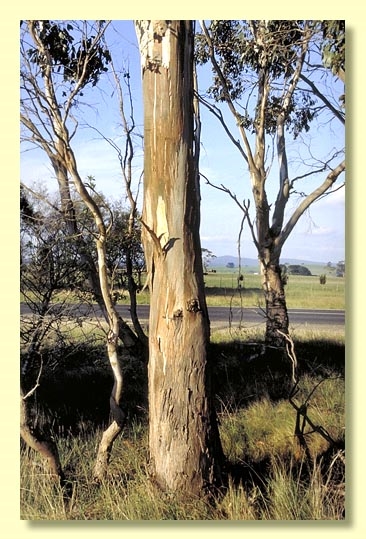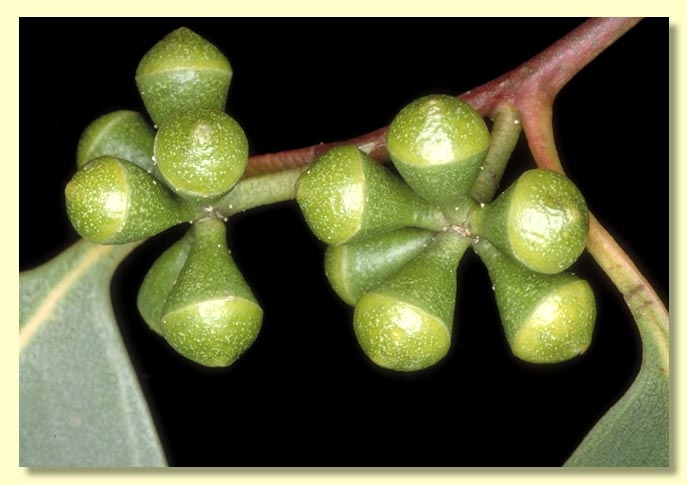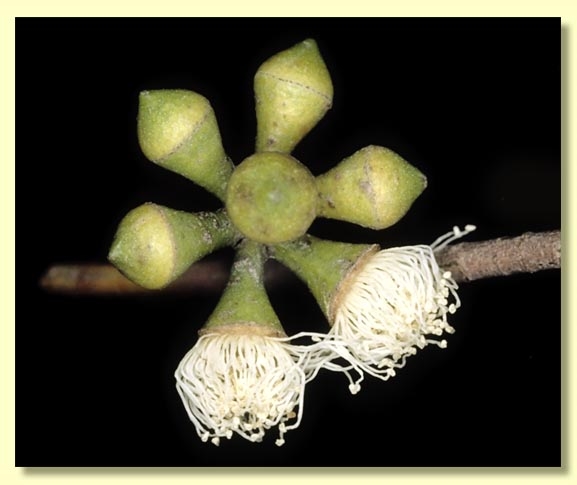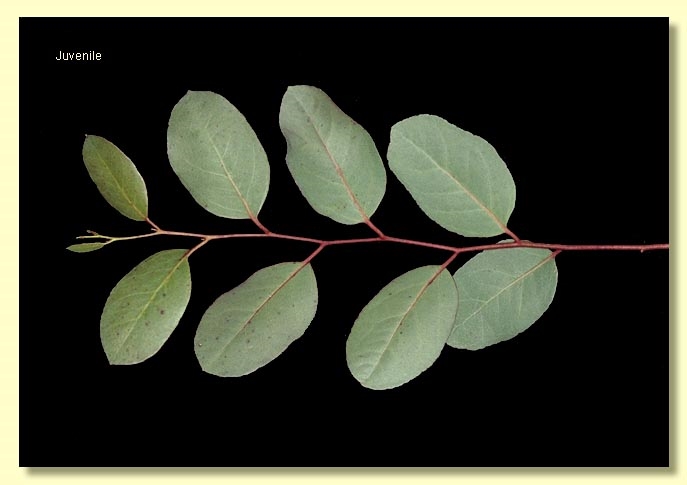Euclid - Online edition
Eucalyptus ovata subsp. ovata
Eucalyptus | Symphyomyrtus | Maidenaria | Triangulares | Foveolatae
Eucalyptus gunnii var. ovata (Labill.) H.Deane & Maiden, Proc. Linn. Soc. New South Wales ser. 2, 26: 136 (1901), nom. illeg. T: Van Diemens Land [Tas.], J.Labillardière s.n.
Eucalyptus stuartiana F.Muell., ex Miq., Ned. Kruidk. Arch 4: 131 (1856) p.p. T: Tasmania, C.Stuart, s.n.
Eucalyptus muelleri Naudin, Rev. Hort. 406 (1855). T: not designated.
Eucalyptus paludosa R.T.Baker, Proc. Linn. Soc. New South Wales 23: 167 (1898); E. stuartiana var. longifolia Benth., Fl. Austral. 3: 244 (1867). T: locality unknown, W.Woolls s.n.; syn; Twofold Bay, NSW, F.Mueller s.n.; syn: K; isosyn: NSW; Twofold Bay, NSW, A.Oldfield s.n.; syn: K.
Eucalyptus gunnii var. acervula H.Deane & Maiden, Proc. Linn. Soc. New South Wales ser. 2, 26: 136 (1901). T: near Plenty Ra., Vic., F.Mueller s.n.
Bark smooth throughout or with loose, rough, grey to grey-brown bark to variable height on trunk; smooth bark white, cream, pale grey or pink-brown, occasionally powdery.
Juvenile growth (coppice or field seedlings to 50 cm): stem rounded in cross-section; juvenile leaves subsessile at first but soon petiolate, opposite for ca 5–10 pairs then alternate, elliptical to ovate, 3–8.5 cm long, 2.5–6 cm wide, margin crenulate or entire, earliest leaves with lobed or rounded base, later leaves tapering, slightly discolorous, green.
Adult leaves alternate, petiole 1.5–3.3 cm long; blade lanceolate to ovate, 8–18 cm long, 1.6–5 cm wide, usually undulate, base tapering to petiole, concolorous, glossy, green, side-veins greater than 45° to midrib, densely to very densely reticulate, intramarginal vein parallel to and well removed from margin, oil glands usually absent.
Inflorescence axillary unbranched, peduncles 0.3–1.4 cm long, buds 7, normally pedicellate, rarely sessile, pedicels (0)0.2–0.4(0.7) cm long. Mature buds diamond-shaped (0.5–0.9 cm long, 0.4–0.6 cm wide), green, scar present (outer operculum shed early), operculum usually conical, rounded in some coastal forms, rarely beaked, (0.3–0.5 cm long), stamens inflexed, anthers cuneate or cuboid, versatile, dorsifixed, dehiscing by longitudinal slits (non-confluent), style long, stigma blunt, locules 3 or 4, the placentae each with 4 vertical ovule rows. Flowers white.
Fruit sessile or pedicellate, pedicels (0)0.1–0.5 cm long, obconical or slightly campanulate, 0.3–0.8 cm long, 0.4–0.8 cm wide, disc raised-annular, or level, valves 3 or 4, exserted or near rim level.
Seeds brown or grey, 1–2 mm long, ovoid or flattened-ovoid, often pointed at one end, usually lacunose, dorsal surface shallowly pitted, hilum ventral.
Cultivated seedlings (measured at ca node 10): cotyledons bilobed; stems usually rounded to square in cross-section; leaves shortly petiolate, opposite for 5–7 nodes then alternate, ovate-elliptic, 4–10 cm long, 2.5–4.5 cm wide, base rounded to tapering, margin entire or subcrenulate, apex blunt, slightly discolorous, dull, mid-green above, paler below.
Flowering has been recorded in March, June, July, August, October and November.
A swamp gum, usually mostly smooth-barked but often with conspicuous, basal, unshed dead bark, E. ovata is recognised by undulate, glossy green leaves and the rhomboidal (diamond-shaped) buds and obconical fruit (funnel-shaped). It is related to E. yarraensis which differs in the consistent rough bark over the whole trunk and often branches and smaller buds and fruits, and to E. brookeriana which has a stocking of rough bark, discolorous glandular leaves, round to oblong, crenulate, glandular juvenile leaves and fruit which may vary from obconical to cupular. It occupies wet, well-drained fertile sites in contrast to E. ovata which prefers areas of poor drainage or swamps. E. strzeleckii differs from E. ovata most strikingly in having glaucous new tip growth.
There are two subspecies:
E. ovata subsp. ovata
The widespread subsp. ovata has no visible oil glands in the adult leaves. Fruit dimensions 0.3–0.8 cm long, 0.4–0.8 cm wide, they tend to be smaller than those of subsp. grandiflora but there is some overlap.
E. ovata subsp. grandiflora
The more restricted subsp. grandiflora has larger buds and fruits, and prominent oil glands in the adult leaves. It is restricted to the Mount Gambier – Naracoorte – Portland area of South Australia and Victoria. Fruit dimensions 0.6–1 cm long, 0.6–1.3 cm wide.
Eucalyptus ovata belongs in Eucalyptus subgenus Symphyomyrtus section Maidenaria because the cotyledons are bilobed, inflorescences axillary, anthers versatile and seeds flattened-ovoid. Within this large section, E. ovata is one of ten species forming subsection Triangulares series Foveolatae. The species are E. barberi and E. rodwayi (both Tasmanian endemics), E. brookeriana, E. ovata (both occurring in Tasmania and on the mainland) and E. aggregata, E. cadens, E. camphora, E. macarthurii, E. strzeleckii and E. yarraensis (found only on the mainland). Eucalyptus ovata is closest to E. brookeriana, E. yarraensis and E. strzeleckii differing as discussed above. The smooth-barked Tasmanian mallee E. barberi differs from E. ovata in habit and in having obovoid buds and more cupular fruit.















